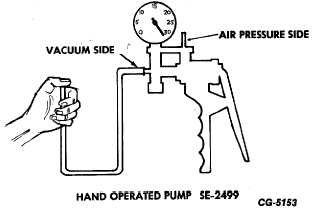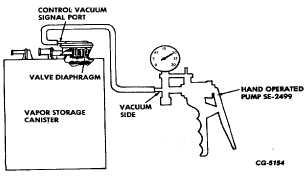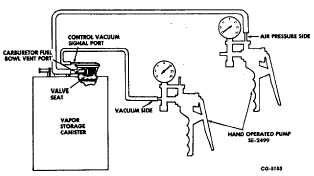|
| |
ENGINE DIVISION SERVICE MANUAL
TM 5-4210-230-14&P-1
It is important that canister hoses be connected to
the proper manifold fitting.
Canister Control Valve Test
Before starting the following test with hand operated
vacuum pump (SE-2499), check pump for leakage (Fig. 14)
by placing a finger over the vacuum port and pump until full or
near full scale is reached. Watch pump gauge. If vacuum
drops rapidly, pump is leaking and should not be used for
test. If a very slow leak is indicated, the pump may be used if
the degree of pump leakage is kept in mind.
Fig. 14 Check Hand Operated Vacuum Pump SE-2499 for
Leakage
1.
Test canister fuel bowl vent control valve diaphragm
by applying vacuum to the control valve port (smaller top port
valve assembly) with hand operated vacuum pump (SE-
2499). Observe vacuum pump gauge (Fig. 15). If vacuum
drops rapidly the control valve diaphragm is leaking and the
canister must be replaced.
Fig. 15 Canister Fuel Bowl Vent Control Valve Diaphragm
Test
2.
The valve seat portion of the fuel bowl vent control
valve can be tested by applying vacuum to the
control valve (same as diaphragm test Fig. 15) and
at the same time (with another hand operated pump
SE-2499 using air pressure side of pump) apply air
pressure to the valve (Fig. 16) until pressure buildup
is felt. If pressure buildup is not felt the valve seat is
leaking and the canister must be replaced.
3.
Test purge control valve diaphragm and valve seat
by applying vacuum with hand operated vacuum
pump (SE1499) simultaneously to both vacuum
signal port and purge port (see Fig. 17). If vacuum
of either pump drops rapidly the valve is faulty and
the canister must be replaced.
Fig. 16 Canister Fuel Bowl Vent Control Valve Seat Test
Fig. 17 Canister Purge Control Valve Diaphragm and Valve
Seat Test
CGES-215 Page 12
PRINTED IN UNITED STATES OF AMERICA
|




